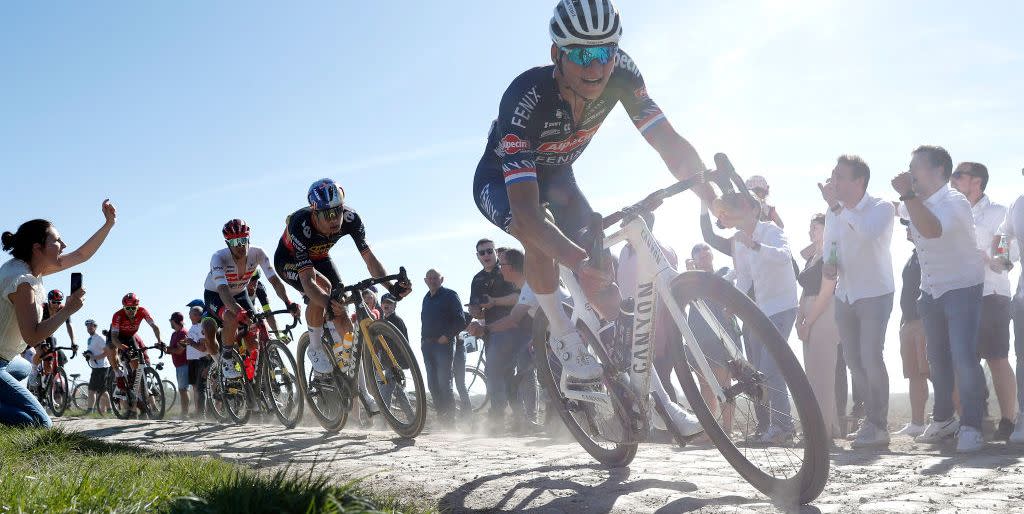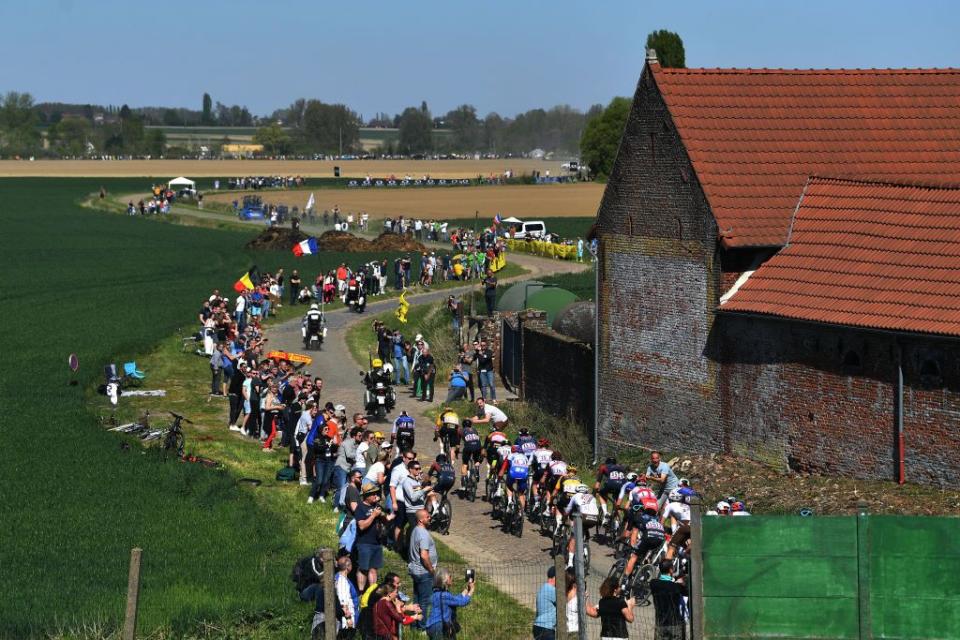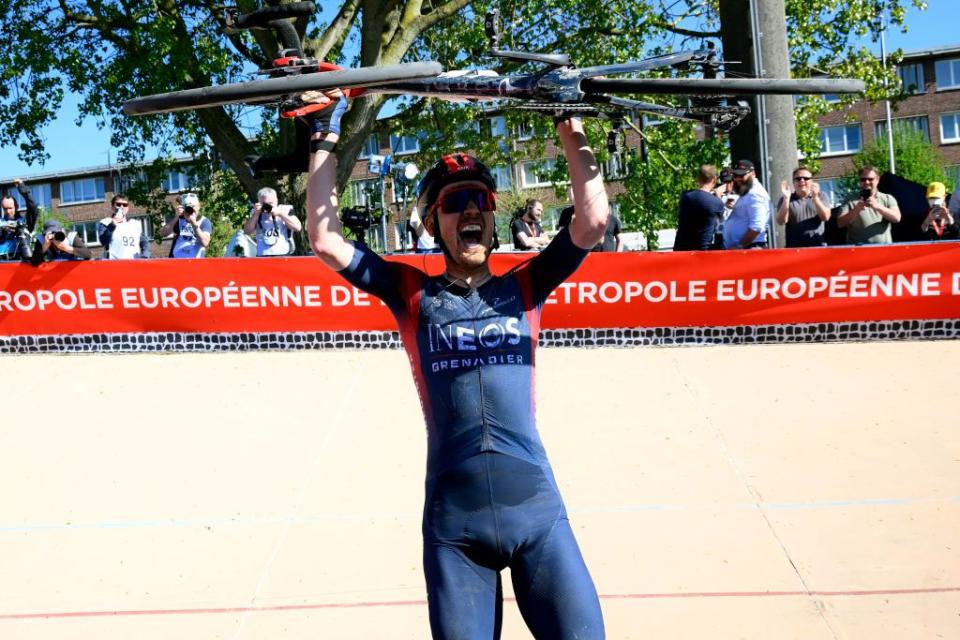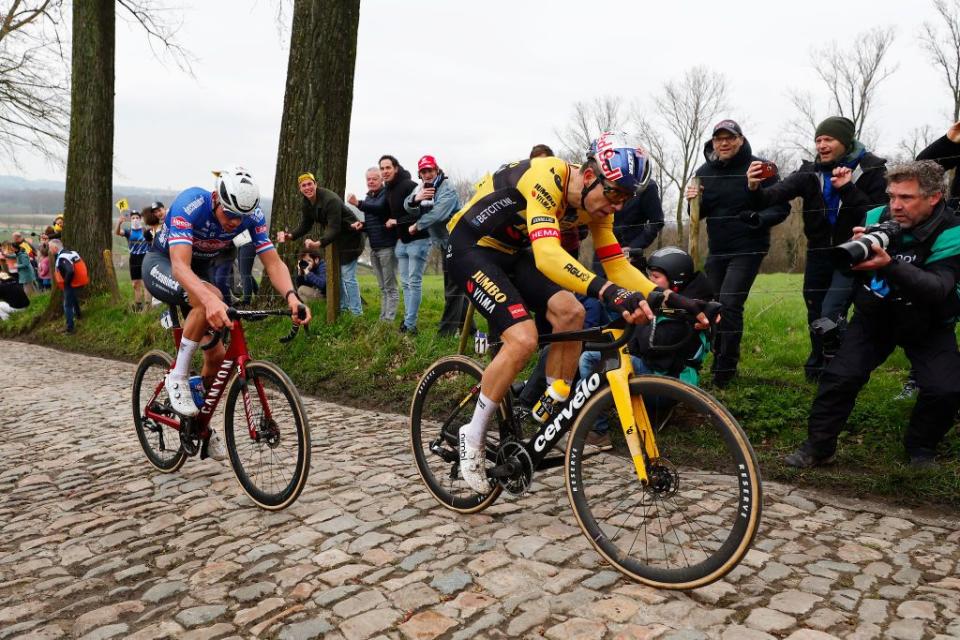How to Watch Men’s Paris-Roubaix

- Oops!Something went wrong.Please try again later.
"Hearst Magazines and Yahoo may earn commission or revenue on some items through these links."
The season’s third Monument, Paris-Roubaix gets its nickname from the 54.5K of cobbled roads that the riders tackle as the race winds its way through the windswept fields of northern France–many of which were heavily shelled during World War I.
The riders who excel in Roubaix are often the same who were at the front at last weekend’s Tour of Flanders, which is why many riders who have won Flanders have also won Roubaix. But that won’t be happening this year as Slovenia’s Tadej Pogačar (UAE Team Emirates), last Sunday’s winner, won’t be taking the start. The two-time Tour de France winner just isn’t ready to test himself in an event without any climbs.
But don’t worry: the Netherlands’ Mathieu van der Poel (Alpecin-Deceuninck) and Belgium’s Wout van Aert (Jumbo-Visma) are ready to continue their rivalry, with both looking to add their first cobbled trophy (yes, the winner gets their own cobblestone) to their already-crowded mantelpieces.
Here’s everything you need to know about this Sunday’s men’s Paris-Roubaix:
The Route

Since 1977, Paris-Roubaix has started in the town of Compiègne, about an hour northeast of the French capital. From there, the race heads north through Picardy region of northern France, an area encompassing the departments of Oise, Aisne, and Somme, areas heavily impacted by the horrors of World War I.
The riders will cover these smooth, rolling roads during the first two hours of the 256.6K race, with a large breakaway likely escaping containing a mix of riders from wild card squads looking for publicity and domestiques from the contenders’ teams looking to position themselves to support their captains later in the race. Despite the lack of cobblestones, this early phase of the race can be dangerous: crashes and crosswinds are common.
But Paris-Roubaix is all about cobblestones (known locally as “pavé”), and there are 54.5K of them spread over 29 sectors, which are numbered in descending order from 29 to 1. The riders hit the first sector in Troisvilles–about 96K into the race–and from there it’s pretty much “game on'' as the race winds its way toward Roubaix along the border between France and Belgium.
Each cobbled sector is inspected in the days prior to the event and given a star rating to indicate its difficulty. This year’s race has three 5-star sectors and six 4-star sectors, the first of which comes 110K into the day, at Saint Python. But let’s be clear: every sector offers its own set of challenges, and none can be considered “easy.”
The cobbles turn Paris-Roubaix into a race of attrition and anticipation, as riders are steadily dropped from the back of the peloton due to fatigue, mechanicals, or crashes. The better riders and teams keep themselves at the front and on the center crown of each cobbled sector, both to dictate the pace of the race and to avoid inevitable mishaps as the pace winds up and the kilometers tick down.
Things come to a head with about 95K to go as the riders hit Sector 19, the Arenberg Forest, one of the hardest and most famous in the race. A long, fast sector that features some of the race’s gnarliest cobblestones, the pack usually splits into pieces here as the contenders accelerate to try and force the first major selection of the day. Riders who get dropped might never see the front of the race again.
Other key sectors include Sector 11 (Mons-en-Pévèle), a long and brutal sector that often shapes the final hour of the race; and Sector 4 (Carrefour de l'Arbre), which often provides the perfect launchpad for riders hoping to drop their breakaway companions and ride away to victory.
And if they don’t, the velodrome awaits, where a small group of exhausted riders will need to muster enough mental and physical energy to master a sprint on the ancient concrete track. Upsets are common here, such as in 1997 when France’s Frédéric Guesdon burst from the back of a group of favorites to win; and in 2016 when Australia’s Mathew Hayman denied Belgium’s Tom Boonen a chance to take his record-breaking fifth Roubaix victory.
After a couple of days of rain, the riders will be happy to see cool, but dry conditions on Sunday. But with many of these roads still being used by farmers, there will be wet spots and puddles, which could mean slippery stones in several places.
How to Watch Paris-Roubaix
If you did what we suggested and subscribed to NBC’s Peacock Premium before last year’s Tour de France ($4.99/month), you get Paris-Roubaix and several other races covered by NBC and its partners. (Although you’ll need to renew prior to the start of this year’s Tour.) If you’re looking for ad-free coverage, you’ll need a subscription to Peacock Premium Plus, which runs $9.99 a month.
The Peacock app is available on Roku, Apple devices, Android and AndroidTV devices, Google platforms, Chromecast, Xbox devices, Playstation 4 and 4 Pro, VIZIO SmartCast TVs, and LG Smart TVs. You can also watch online via the Peacock website.
If you’re in Canada, FloBikes ($149.99/year) is the best way to watch Paris-Roubaix, with all 21 stages available live and on-demand on FloBikes.com, the FloSports IOS app, and the FloSports app for Amazon FireTV, Roku, and Apple TV.
We’ll be up early to watch the riders hit the cobbles in Troisvilles (at about 7:30 a.m. EDT). Assuming the expected average speeds are accurate, the leaders will hit the Arenberg Forest at about 9:00 a.m. EDT, and Mons-en-Pévèle at about 10:15 a.m. EDT. At this point the riders will be going full gas to the finish, so settle in for an exciting hour.

What Happened Last Year
The Netherlands’ Dylan van Baarle (INEOS Grenadiers) followed-up his second-place finish in the Tour of Flanders by winning Paris-Roubaix two weeks later. The Dutchman attacked a 4-man leading group with 18K left to race, riding alone into the velodrome to take the biggest win of his career. Belgium’s Wout van Aert (Jumbo-Visma) won the sprint for second, 1:47 behind van Baarle; Switzerland’s Stefan Küng (Groupama-FDJ) finished third.
In Roubaix, winning moves often go earlier than conventional wisdom might dictate, and Van Baarle timed his attacks so as to get the better of the race’s more favored contenders, putting himself one step ahead of men like van Aert and van der Poel. His final attack on the cobbles of Camphin-en-Pévèle gapped his exhausted breakaway companions, and by the time a select chasing group containing van Aert and Küng clawed their way back to the front van Baarle was already gone and on his way to victory.
Riders to Watch
Mathieu van der Poel (Alpecin-Deceuninck)
Were it not for Slovenia’s Tadej Pogačar (UAE Team Emirates), Mathieu van der Poel would have won his third Tour of Flanders in four years last Sunday, tying him for the most wins in Flanders history. Clearly anyone who thought the Dutchman might have dropped-off after winning his first Milano-Sanremo three weeks ago was clearly wrong, and several riders–most recently Germany’s John Degenkolb–have actually won both the Italian and French Monuments in the same season. Van der Poel raced Wednesday’s Scheldeprijs semi-Classic on Wednesday, and after taking a long, hard pull at the end of the race to help his Belgian teammate Jasper Philipsen sprint to victory, he declared himself ready for Roubaix. He’s the top favorite.

Wout van Aert (Jumbo-Visma)
Belgium’s Wout Van Aert came up short again at the Tour of Flanders last Sunday after getting dropped by van der Poel’s late-race acceleration on the Kruisberg. He settled for fourth, a disappointment considering how well he and his team have been racing this spring. Roubaix is van Aert’s last chance to add a cobbled Monument to his resume this season, and his team has done everything in its power to surround him with the support he needs to get over the hump, including signing van Baarle this past off-season. But this could work against him: if one of his teammates gets away late in the race, van Aert will be forced to choose between racing for himself and doing what’s best for his team, a situation similar to the one that happened in last year’s World Championships when van Aert missed a chance for a medal because his Belgian teammate, Remco Evenepoel, had escaped to win the race himself.
Stefan Küng (Groupama-FDJ)
Over the past few seasons, Switzerland’s Stefan Küng has become the best non-Benelux cobbled classics rider, highlighted by his third-place finish in last year’s Paris-Roubaix. A powerful rider known for his superior time trialing skills, Küng has two Roubaix winners back in his team car (Guesdon and Marc Madiot) which means he benefits from his directors’ expert knowledge of the terrain to help him. If van der Poel and van Aert spend too much time focusing on one another, Küng could escape to win the race himself, the first Swiss rider to do so since 3-time winner Fabian Cancellara.
Yves Lampaert (Soudal-Quick Step)
Belgium’s Yves Lampaert has become a Roubaix specialist in recent years, focusing all of his spring efforts on winning the cobbled Monument. This year he’s out for a bit of revenge: seemingly on his way to a podium finish last year, he crashed spectacularly after hitting a spectator’s arm with about 8K to go–ultimately settling for tenth. Lampaert’s had a trouble-free start to his season and should benefit from being a bit of an outsider on Sunday, and even though his team has failed to win a cobbled classic so far this season, it’s still one of the deepest and most experienced in the peloton. If Lampaert plays his cards right, he could salvage his team’s spring.
Christophe Laporte (Jumbo-Visma)
A Frenchman hasn’t won Roubaix since Guesdon scored his upset victory in 1997, but that could change this year if Christophe Laporte continues to benefit from riding with the strongest team in the world. Laporte won Gent-Wevelgem (a gift from van Aert) two weeks ago and then Dwars door Vlaanderen a few days before Flanders, victories that would make him a top contender–if he weren’t van Aert’s top lieutenant. But Laporte is a dangerous rider who will force other teams to make a decision if he goes on the attack: do we chase him and risk pulling van Aert into contention, or do we let him go and hope that others will pick up the pursuit? In a race that often rewards opportunists, Laporte could be the latest in a long line of domestiques who have taken the biggest wins of their careers at Roubaix.
You Might Also Like

